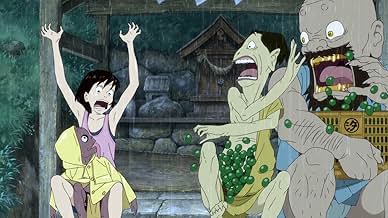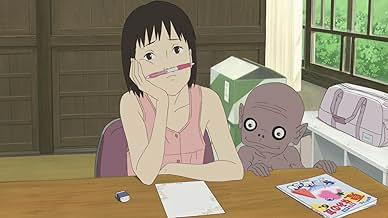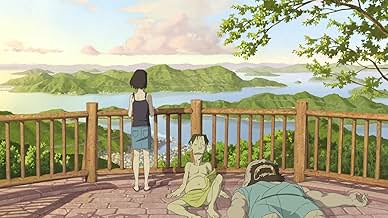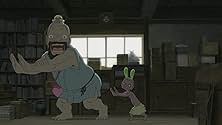Aggiungi una trama nella tua lingua11-year-old Momo moves with her mother to a small island town after her father dies. When she arrives, she encounters three goblins that others cannot see who try to help her to cope with th... Leggi tutto11-year-old Momo moves with her mother to a small island town after her father dies. When she arrives, she encounters three goblins that others cannot see who try to help her to cope with the loss of her father and the changes in her life.11-year-old Momo moves with her mother to a small island town after her father dies. When she arrives, she encounters three goblins that others cannot see who try to help her to cope with the loss of her father and the changes in her life.
- Premi
- 3 vittorie e 7 candidature totali
- Momo Miyaura
- (voce)
- Ikuko Miyaura
- (voce)
- Iwa
- (voce)
- Kawa
- (voce)
- Great Auntie
- (voce)
- Koichi
- (voce)
- Umi
- (voce)
- Momo Miyaura
- (English version)
- (voce)
- Ikuko Miyaura
- (English version)
- (voce)
- Kazuo Miyaura
- (English version)
- (voce)
- Iwa
- (English version)
- (voce)
- Kawa
- (English version)
- (voce)
- Mame
- (English version)
- (voce)
- Great Uncle
- (English version)
- (voce)
Recensioni in evidenza
Their appearances are reminiscent of "Kyoka Hyakki Yakyo," an illustration of goblins in an Edo-era comic book called "Kibyoshi." "Kibyoshi" is a precursor of 'manga.' In the Edo era, various images of goblins entertained readers and told valuable lessons.
The film is set in Shio Shima, Inland Sea, an allusion to Yasujiro Ozu's classical film "Tokyo Story." Momo moves from Tokyo to the small island after her father's sudden death. While she is boarding a ship, three drops of spirits come down from the sky and land on her. The drops are the goblins or guardians, which help her reconcile a sad memory about her father. She regrets criticizing her father before he passed away.
In the film, the legendary goblins and Momo develop strange but warmhearted relationships that unite the past and present, or this world and afterlife. A motif of connectedness appears at various levels and creates a poignant but cheerful story. First, it shows continuation of time in Japanese popular culture by making a connection with the funny goblins emerging from a "kibyoshi" and in Momo's contemporary life. The past is linked to the present via 'manga.' The emergence of old 'manga'unfolds a history of Japanese popular culture, which intertwines with her daily life and symbolizes continuity.
Second, the connectedness illustrates the relationships between the spirits and humans in a spectacular way. Various types of spirits such as orchard spirits, ocean spirits and forest spirits assist Momo. This is most memorably exemplified when the spirits collaborate to help her in the midst of a fierce typhoon. Thanks to their support, she overcomes a difficulty. Demonstrating collective forces, the animating spirits generate a harmonious and splendid message that life is working with others. Nobody can live alone.
In addition, the scene also gives us a lesson. Each one of the vigorous spirits provides her with a tiny power that is almost negligible, but its contribution is valuable and finally brings a tremendous result to aid her. It reminds us that selfishness and indifference do not bring anything good. The significant message is that everybody has a role to play in the world. The scene is a pivotal moment of her spiritual growth.
Furthermore, the connectedness with the spirits also underlines a powerful animistic note that we are part of nature, which exerts enormous power and is larger than us. Nature and humans can coexist harmoniously in this world. The connectedness is the key that keeps our lives going.
Third, the connectedness demonstrates that death is not the end of life. The goblins have been sent from Above in order to watch over the living. Their special mission is to rally round Momo and report about her life to Above. Their mission expresses a vastness of time in human life, including the afterlife. In short, the dead also have a mission to do in this world. A person's life in this world is finite, but one receives another mission to complete in the afterlife. The amicable relationships between the hilarious goblins and her imply that the deceased can also return to this world and work together with the living. The connection between the dead and the living indicates a culture of ancestor worship, emphasizing the relationships between ancestors and offspring, or the past and present.
Accordingly, the story offers a strong viewpoint that it is possible that we can be befriended by spirits or the deceased. A sense of infinite life is an unforgettably emotional moment and contributes to her psychological relief that she has another chance to make up with her father. Finally, the togetherness ameliorates her hardship. All the connectedness is linked to a process of her reconciliation with her regret.
This film would be particularly appealing for victims of the unprecedented great earthquake and tsunami that struck Japan in 2011. Many people unexpectedly lost their loved ones and everyday lives. They were totally unprepared to suffer such tragedies, let alone time to bid farewell. Later, they left their familiar lands and have been struggling with new environments.
In the film, such sentiments are clearly illustrated. Momo's father had an accident at sea and never returned. Her relocation to Shio Shima is an outcome of the loss of her father. The abrupt loss echoes Japanese collective grief and sorrow for those affected by the unbearable incidents.
Likewise, Momo's struggle is part of their struggle. Her feeling of sadness is theirs; her tears are theirs. Eventually, her achievements foreshadow their hopefulness. The story captures her shuttered heart as a reflection of theirs. It epitomizes Japanese psychology – many people hesitate to talk about their tragedy because it is negative.
The film finally offers a moment of catharsis and kindles a flame of hope. Consequently, underlining the importance of familial bonds and hopes that keep them going toward their future, "A Letter to Momo" is a letter to those victims.
More importantly, the story conveys Japanese Gambaro spirit that is an encouragement for people to work hard. The spiritual essence cultivates a sense of esprit-de-corps and persistence. Gambaro spirit is a sense of working hard together and for others, who will help us sometime and somewhere.
Ultimately, intersecting beings from the afterlife with this world, the film informs us of a traditional belief that invisible spirits live together in this world in order to help us.
All the deceased are our guardians, so chin up!
This feels like a long lost Studio Ghibli film, as it has a similar to vibe to their chill films like Whisper of the Heart, Only Yesterday, Totoro, etc. The animation is also a similar style to Ghibli in that it has great detail on the facial expressions of the characters and the backgrounds. The story is like a fairy tale that kids could enjoy and get attached to, even if the subject matter can be emotional at times.
You do care for the main character as everyone around her attempts to help her recover. She is also adjusting socially to a new environment that all audiences can connect to.
I'm only docking points because it is still a standard story that has been told many times both in anime and live action. Also, if you are not into films geared towards general audiences and only like mature shows, you can skip this one as well.
I'm glad I checked it out, and its merits a watch if you are a fan of these types of Ghibli-esque dramas.
This is Japanese anime so pure and yet so subtle that, if you watch for the entire two hours, it will slowly but inevitably overwhelm you.
Hiroyuki Okiura has lovingly and painstakingly done hand-drawn images which are deceivingly simple. You only have to pause the film and look closely at that you are seeing to appreciate the detail. Even the rice cooker in the kitchen is an exact match for an actual rice cooker.
The intent clearly was not to move into the more action-packed stories (space, time travel, wars) but to stick with the tried and true tale of a young girl connecting with nature spirits of a sort that are, again, unique to the culture. Very similar to My Friend Totoro, with more of an emotional step-laddering Personally, I loved it Give it a chance and you may be crying by the end.
That goes for the ladies too
Lo sapevi?
- Citazioni
Momo Miyaura: [last words to her father] You're selfish, and you're a liar. I don't care if you come back.
- Colonne sonoreUruwashi Mahoroba: Utsukushiki Basho
(Uruwashi Mahoroba: Beautiful Place)
Lyrics & Music by Yûko Hara
Arranged by Jun'ichi Soga & Yûko Hara
Strings Arrangement by Yûko Hara
Performed by Yûko Hara
I più visti
- How long is A Letter to Momo?Powered by Alexa
Dettagli
- Data di uscita
- Paese di origine
- Siti ufficiali
- Lingua
- Celebre anche come
- A Letter to Momo
- Aziende produttrici
- Vedi altri crediti dell’azienda su IMDbPro
Botteghino
- Lordo Stati Uniti e Canada
- 71.712 USD
- Fine settimana di apertura Stati Uniti e Canada
- 4596 USD
- 27 lug 2014
- Lordo in tutto il mondo
- 6.776.096 USD
- Tempo di esecuzione
- 2h(120 min)
- Colore
- Mix di suoni
- Proporzioni
- 1.85 : 1




























